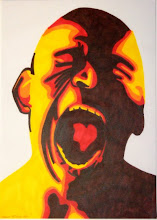
Each of the three selections shown at the close of my International Avant-Garde class' lecture on "Blink" in cinema (Maya Deren's "Meshes Of The Afternoon", Sergei Eisenstein's "Romance Sentimentale", and Luis Bunuel & Salvador Dali's infamous "Un Chien Andelou") in their own way champion the use of the "cut" as a means of regulating a fragmented reality. The three intersect comfortably in that they seem to be attempting to render an accessible representation of the "dream state." However, each work's individual artistic intention stands as what separates it from its neighbor. In all three films, every break obviously works to orient and control our perception, but what is more interesting is that each seems to work towards a dislocation or "non-reality" while still organizing each image, in the hopes of mimicking the intangible notion of thought.
Meshes Of The Afternoon was created by Maya Deren in an effort to solicit a mythological experience from her audience. Her specific design of the "dream state" lingers on the insular, recollective confusion of unconscious thought, with no premeditated psychological subtext involved (or at least not directly indicated.) Each cut in this work quite successfully facilitates a fluid line of action while sewing together movements and spaces that could only come to meet in dreams. The film's tone is one of sublimated anxiousness, exhibited in the beautifully cautious movements and choreography tactfully performed by Deren herself. Ever languorous, the artist shifts between impossible spaces with a feline grace and intensity, interacting with a realm that to the viewer appears somewhat magical, or even "mythical."
Romance Sentimentale functions in a similar vein. Eisenstein approaches the unconscious from a kind of spatial modality as well, though with less emphasis on artifice and more on undisturbed emotional imagery. He begins by utilizing less authored segments of pastoral, natural landscapes, slowly interjecting the images of these spaces with highly augmented moments of animation, contrapuntal sound, and other blatant editorial hand-work. This self-reflexive "hand" in the work changes the discussion of cut as "blink" because it implies an awareness, even a form of strategy, in the arrangement of images, which Meshes seems to try and avoid.
The final film of the triplet, Un Chien Andalou, stands well away from the other two works in terms of device and intention. Dali and Bunuel were actively working to create an entirely inaccessible dream space or alternate reality that lacked any order or association. Of course, the pair underestimated the mind's tenacity in creating meaning where none exists. The work is well crafted and contains some startlingly attractive imagery, but the work fails in its intention of voiding the images of their inherent meaningfulness. It would be interesting to see the three films cut together as one massive psycho-space; perhaps then a true "Exquisite corpse" could be stitched from each film's individual perspective of the human mind at rest.

No comments:
Post a Comment